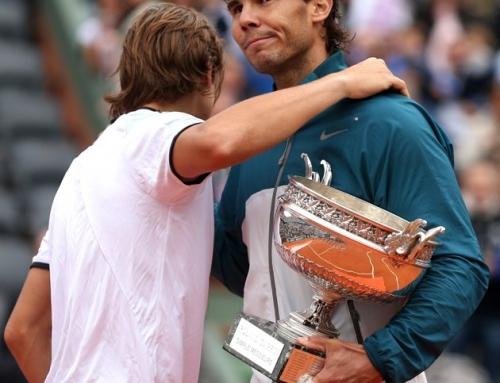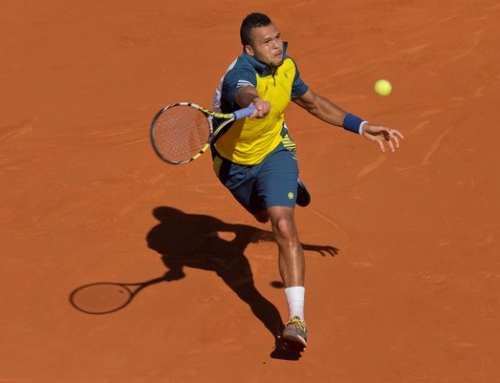 It’s been more than two years since Roger Federer and Rafael Nadal have been in the finals of a Slam. This used to be more routine because Federer kept making it to final after final. That streak was stopped last year at the French Open when Federer lost to Soderling in the quarterfinals. Federer also lost in the quarters of Wimbledon and the semis of the US Open. Rafa won all three of these Slams in his best year.
It’s been more than two years since Roger Federer and Rafael Nadal have been in the finals of a Slam. This used to be more routine because Federer kept making it to final after final. That streak was stopped last year at the French Open when Federer lost to Soderling in the quarterfinals. Federer also lost in the quarters of Wimbledon and the semis of the US Open. Rafa won all three of these Slams in his best year.
At the start of the French Open, Djokovic and Nadal were considered the odds-on favorite to reach the finals. Although Roger Federer has been playing very good tennis since just after Wimbledon last year, he has lost to his rivals quite a few times. Federer has only lost to two other players not named Djokovic or Nadal. That was Jurgen Melzer at Monte Carlo and Richard Gasquet at Rome. Arguably, Federer didn’t want to meet either Djokovic or Nadal too soon. If he had some new way to play his biggest rivals, he wanted it under wraps until Paris.
Most people felt if Djokovic and Nadal were at the top of their games, they wouldn’t be denied. So it was with some amazement that Roger Federer found a way to play Djokovic. He had, up to the semifinals, played some tough opponents. Stan Wawrinka, Feliciano Lopez, Gael Monfils. True, Federer has a very good record against all three, but they are nonetheless quality opponents. If he struggled with any of them (which he didn’t), it might indicate problems with Roger’s game. The fact that he dispatched them all in straight sets was an indicator that his game was in pretty good shape.
Having said that, Federer didn’t drop a set either last year until he met Soderling, then lost to Soderling. However, he also didn’t beat as many tough opponents. His biggest win up to that point was Stan Wawrinka.
Nadal, for his part, started this event in a similar fashion to Wimbledon. At Wimbledon, Nadal had two five setters, one against Robin Haase, the other against Philipp Petzschner. He won both, then with people wondering how his form was, he handled Robin Soderling, then beat Murray in four sets, then handled Berdych in the finals.
This time, Nadal beat Isner in 5 sets–his first five setter at Roland Garros ever, then struggled against Pablo Andujar, had an easy time with Antonio Veic, played a solid match against Ivan Ljubicic, played his best match against an off-form Robin Soderling, and then kept his nose out in front of Andy Murray who had chances to break.
If Nadal wanted to avoid someone, it would have been an in-form Novak Djokovic who seemed to have figured out a way to play Nadal.
Now he doesn’t have to worry about Djokovic. Instead, he gets to play his longtime rival, Roger Federer. Although Federer had the “tougher” of the two matches, in that it went to two tiebreak, his win was in just under four hours. Nadal’s win was in straight sets, but he was still kept on court for three hours.
The big question, despite Federer’s great achievement in breaking “the streak” is whether he can beat Rafa. Although Djokovic’s streak was daunting, Federer could at least take solace in the fact that he had beaten Novak Djokovic four of five times last year, and even the single loss he had to Djokovic was very close–Roger had match points on Djokovic. True, he lost to him three times this year (Melbourne, Dubai, and Indian Wells), but at least the wins were more recent.
Now, Roger did have to play a great match to beat Djokovic which consisted of serving well, moving well, defending well off his backhand, and staying mentally tough. Roger often plays matches against his rivals like this. For example, when he beat Rafa in Madrid in 2009, Rafa was threatening to break back in the second set. Had he done so, maybe it goes a third set and Roger doesn’t win. Similarly, Djokovic broke Roger late in the fourth set. Fortunately, Roger broke back right away.
Nadal will, of course, be favored to take his sixth title at Roland Garros to equal the great Bjorn Borg. As much as Federer handled Djokovic, Djokovic does play a style that’s a bit friendlier to Federer. In particular, no one loops the ball like Nadal does.
But, despite being favored to win, Federer has a few things that might work in his favor. First, Nadal isn’t playing with the same kind of form he played last year. Last year, he won Monte Carlo, Rome, and Madrid. He steamrolled to his fifth French title without dropping a set. 2008 was even more dominant with Nadal steamrolling Federer in the finals. Nadal lost to Djokovic twice. That seems to have played a few games with his head.
Federer has also played arguably better tennis to reach the finals facing three tough opponents and one very tough opponent. He should be feeling like he did at London when he swept his round-robin, then beat Djokovic in the semis and Nadal in the finals.
Federer has played done several things very well, especially against Djokovic. First, Federer is moving very well for his age. One problem that hurt him last year at Roland Garros and Wimbledon was his leg/back issues which prevented Roger from moving at his best. When that happens, Roger begins to shank balls more and go for bigger shots. Roger seems to trust his movement more this year, so he’s able to play safer shots and stay in rallies longer.
He’s also hitting his backhand nearly as well as he did when he won the 2010 Australian Open. In Melbourne, Roger was not only hitting steady off his backhand–something Andy Murray tested him on in the finals, but he was also hitting winners off that backhand. Alas, Roger’s form slipped after that. He skipped Dubai due to a fever, and once he returned to action in the US, his marvelous backhand seemed to have receded some. It seems like it’s taken over a year to begin to build that backhand.
Roger wants his backhand to be solid enough to defend. It’s probably not good enough to be completely offensive. He’s not Richard Gasquet.
Roger also served very well. It says something that he put in 18 aces, numbers that seem more common at Wimbledon than at the slow clay. There was one factor that was working in Roger’s favor. Djokovic seems to struggle under dusk conditions. Recall his match against del Potro. That’s when he was missing shots and when del Potro took a set off him. When they played in bright daylight, Djokovic took over the match.
But one other aspect that Roger really needs is to return well against Rafa. Rafa tends to win his matches against Roger because Roger struggles inordinately with Rafa’s serve. Rafa wins enough free points off his serve to make breaking him very tough. It might be some comfort that he had plenty of break points against Djokovic and that Murray also had plenty of break points against Rafa. The problem is converting those break points.
The best players aren’t just the best because they hit the ball better than almost everyone else, but in those occasions when they get into trouble, they somehow figure out how to extricate themselves out of messes. Murray would have beaten Rafa a few times by now if he could manage to pull the trigger and actually have a ball land in during the biggest points. Rafa got him here at Roland Garros and pretty much did the same to him at Wimbledon last year. Rafa fights off break points as well as anyone. He does it partly by hitting the big shots when he needs to, and partly by errors from his opponents.
Roger knows this pain all too well. When Rafa beat Roger in the finals of the 2008 Wimbledon–some call this the best match every played, Roger failed time and again to break Rafa. He had plenty of opportunities in the first two sets, and converted only once. Then, those opportunities disappeared and he needed to win sets in tiebreaks as well as hold his own serve.
Roger has to make Rafa work on his serve. To this end, Rafa is employing an interesting strategy. At the US Open last year, and indeed in the 1-2 tournaments leading up to the US Open, Rafa had altered his grip to give him a flatter delivery. This added maybe 10 mph more to his serve. It was near impossible to break Rafa during that US Open. However, that Rafa delivery seemed to disappear after the US Open possibly because it caused a shoulder aggravation.
Rafa’s strategy throughout the French has been to keep his first serve percentage high, which is his normal strategy. He normally serves in the mid to high 70%. Can Roger take advantage of a slower delivery? Historically, he hasn’t, but he needs to if he wants to win. Roger had a hyper-aggressive strategy used at London, but several things favored Roger in the finals of the ATP World Tour Finals.
In particular, Nadal was pushed several hours by Murray in the semifinals while Roger had a relatively easy win over Djokovic, but also because the surface was indoors, not clay. And Rafa still won a set under those circumstances.
Roger would, of course, love to win the French. Although he claims his career doesn’t need any validation, that his 2009 win was as legitimate as any win, even if it wasn’t against Rafa, having a win against Rafa at Roland Garros would really cement his career victories. Maybe in a few years Rafa will be looking to eclipse those results, but Roger’s chances to beat Rafa have never been as great as they are now. He’s playing well. Rafa’s not at his very best.
And yet, this is Rafa’s tournament. He’s owned Roland Garros for so long. Roger will need another pitch perfect match against a very different player. Obviously, if anyone can do it, Roger can. If he does, then he can thank Annacone for whatever keen observations he may have made. One interesting note. Historically, it’s been dangerous to drop shot Rafa. However, Murray showed it can be done. When Federer beat Rafa back in 2009 in Madrid he did not resort to the drop shot much.
Anyway, I think Rafa in four sets. Let’s see what happens.




![[French Open] The tactics of the Djokovic-Nadal semifinals](https://www.essentialtennis.com/wp-content/uploads/2013/06/20130607nole-500x383.jpg)
![[French Open, SF] David Ferrer defeats Tsonga in straight sets to reach first Slam final](https://www.essentialtennis.com/wp-content/uploads/2013/06/20130607ferrer-500x383.jpg)
![[French Open, SF] Nadal escapes epic 5-setter with win over Djokovic, to compete for 8th title](https://www.essentialtennis.com/wp-content/uploads/2013/06/20130607rafa-500x383.jpg)
